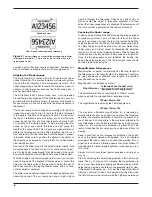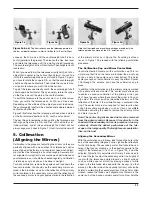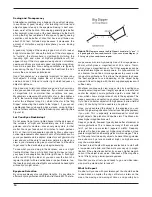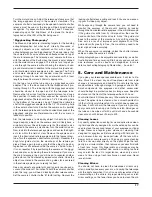
15
dreds of deep sky objects. Do not expect to see as much color
as you in NASA photos, since those are taken with long-expo-
sure cameras and have “false color” added. Our eyes are not
sensitive enough to see color in deep-sky objects except in a
few of the brightest ones.
Remember that you are seeing these objects using your own
telescope with your own eyes! The object you see in your
eyepiece is in real-time, and not some conveniently provided
image from an expensive space probe. Each session with
your telescope will be a learning experience. Each time you
work with your telescope it will get easier to use, and stellar
objects will become easier to find. Take it from us, there is big
difference between looking at a well-made full-color NASA
image of a deep-sky object in a lit room during the daytime,
and seeing that same object in your telescope at night. One
can merely be a pretty image someone gave to you. The other
is an experience you will never forget!
A. The Moon
With is rocky and cratered surface, the moon is one of the
most interesting and easy subjects for your scope. The best
time to view it is during its partial phases when shadows fall
on the craters and canyon walls to give its features definition.
While the full moon may look like a tempting target, it is actu-
ally the worst time for viewing! The light of a full moon is too
bright and lacks any decent surface definition.
Use an optional Moon filter to dim the Moon when it is very
bright. It simply threads onto the bottom of the eyepiece from
the focuser (you must first remove the eyepiece from the
focuser to attach the filter). You’ll find the Moon filter improves
viewing comfort, and helps bring out the subtle features in the
lunar surface.
B. The Bright Planets
The planets don’t stay put like stars do, so you will have to refer
to charts published monthly on our website, telescope.com, or
other astronomy references to locate them. Venus, Mars,
Jupiter, and Saturn are the brightest objects in the sky after
the Sun and the Moon. All four of these planets are not nor-
mally visible in the sky at one time, but chances are one or
two of them will be.
JUPITER The largest planet, Jupiter, is a great subject to
observe. You can see the disk of the giant planet and watch
the ever-changing positions of its four largest moons, Io,
Callisto, Europa, and Ganymede. If atmospheric conditions
are good, you may be able to resolve thin cloud bands on the
planet’s disk.
SATURN The ringed planet is a breathtaking sight when it is
well positioned. The tilt angle of the rings varies over a period
of many years; sometimes they are seen edge-on, while at
other times they are broadside and look like giant “ears” on
each side of Saturn’s disk. A steady atmosphere (good see-
ing) is necessary for a good view. You may see a tiny, bright
“star” close by; that’s Saturn’s brightest moon, Titan.
VENUS At its brightest, Venus is the most luminous object in
the sky, excluding the Sun and the Moon. It is so bright that
sometimes it is visible to the naked eye during full daylight!
Ironically, Venus appears as a thin crescent, not a full disk,
when at its peak brightness. Because it is so close to the Sun,
it never wanders too far from the morning or evening horizon.
No surface markings can be seen on Venus, which is always
shrouded in dense clouds.
MARS If atmospheric conditions are good, you may be able
to see some subtle surface detail on the Red Planet, possibly
even the polar ice cap. Mars makes a close approach to Earth
every two years; during those approaches its disk is larger
and thus more favorable for viewing.
C. Stars
Stars will appear like twinkling points of light in the telescope.
Even the largest telescopes cannot magnify stars to appear
as anything more than points of light! You can, however, enjoy
the different colors of the stars and locate many pretty double
and multiple stars. The famous “Double-Double” in the con-
stellation Lyra and the gorgeous two-color double star Albireo
in Cygnus are favorites. Defocusing the image of a star slight-
ly can help bring out its color.
D. Deep-Sky Objects
Under dark skies, you can observe a number of brighter
deep-sky objects with your AstroView 6 EQ, including
gaseous nebulas, open and globular star clusters, and the
brighter galaxies. Most deep-sky objects are very faint, so it is
important that you find an observing site well away from light
pollution. Take plenty of time to let your eyes adjust to the
darkness. As you become more experienced and your
observing skills improve, you will be able to coax out more
and more intricate details.
Finding Deep-Sky Objects: Starhopping
Starhopping, as it is called by astronomers, is perhaps the
simplest way to hunt down objects to view in the night sky. It
entails first pointing the telescope at a star close to the object
you wish to observe, and then progressing to other stars clos-
er and closer to the object until it is in the field of view of the
eyepiece. It is a very intuitive technique that has been
employed for hundreds of years by professional and amateur
astronomers alike. Keep in mind, as with any new task, that
starhopping may seem challenging at first, but will become
easier over time and with practice.
To starhop, only a minimal amount of additional equipment is
necessary. A star chart or atlas that shows stars to at least
magnitude 5 is required. Select one that shows the positions
of many deep-sky objects, so you will have lots of options to
choose from. If you do not know the positions of the constella-
tions in the night sky, you will need to get a planisphere to
identify them.
Start by choosing bright objects to view. The brightness of an
object is measured by its visual magnitude; the brighter an
object, the lower its magnitude. Choose an object with a visu-
al magnitude of 9 or lower. Many beginners start with the
Messier objects, which represent some of the best and bright-
est deep-sky objects.
Summary of Contents for AstroView 6 EQ 9827
Page 19: ...19 ...





























